“Effect of Advertising Slogans on Young Consumer’s Buying Behavior; with special reference to Bhopal city”
Ritu Bhavsar[1]
Abstract:
India has the largest youth population in the world. Around 66% of the total population is below the age of 35. Youths are the most potential buyers and consumers of India. Advertisers are working hard to modify their strategies every day to fulfil rising expectations of youth. The purpose of this study is to analyse the effectiveness of advertising slogans on young consumer’s buying behavior. An advertising slogan is a short and catchy phrase that seeks to reinforce the image of the brand of any company. Slogans are an important element of advertising and 2/3rd of global Ads contain slogans. The data was collected from 75 respondents from Bhopal city. A descriptive research design is adopted to analyse and draw conclusion. SPSS as a tool is used to draw inferential results. The study concludes that slogan has potential to change consumer’s buying behavior and has positive effect on their purchase intention.
Keywords; Slogan, Young Consumer, Buying Behavior, Advertising.
Introduction:
An advertisement should serve to inform, persuade and remind consumer about the brand. For making an advertisement successful each of its elements plays an important role. Advertising slogan; an important element of advertisement communicates the core message of whole ad. It has potential to change consumer perception towards a brand and also influence their buying behavior. In present scenario where consumers are acquainted with plenty of brands to cater their one need and that too easily accessible, it becomes very important to understand effect of slogans on consumers. This study aims to analyse effect of advertising slogans on the young consumer’s buying behavior. The study will also be beneficial for the marketers and advertisers and surely provide them with a better way to improvise advertising slogans.
A product is something that is manufactured in the factory and brand is something bought by the consumer. To enhance the brand equity and awareness advertisers use the slogans (Alamgir et al. 2010). There are two factors that affect the consumer behavior are slogans and brand names (Kristy and Sandra, 2011). Consumer behavior is influenced by the different marketing tactics such as slogans, logos, pricing and sales person (Juliano et al. 2011). An advertising slogan is a short and catchy phrase that seeks to reinforce the image of the brand of any company. Slogan has following characteristics:
- A statement on the specific features of product or service.
- It is worth repeating and helps the consumer to recall the product.
- It is important to audience to remember the product.
- It is easy to remember.
Slogans are familiar features of advertising and 2/3rd of global ads contain slogans. Among all TV ads include slogans, 44% brand name, 36% include slogans that used before and 7 % include slogans to set music. Slogans are key elements in communication and advertising strategies. Slogans are short message that depicts the features and advantages of product. Slogans are closely related to brand and help the company to transmit the idea to consumer that they want to be (Maria Luisa, 2014). In United States consumer of 18 years watch 350,000 advertising and slogans act as a carrier of brand equity. Slogans act as a preserver of brand identity and part of every advertising campaign. Supphellen and Nygaardsvik (2002) introduce a three-stage model for testing slogans. The first stage measure qualitative associations descripted by slogans, second stage measure the remembrance and recall due to slogans and third measures the brand attitude and image developed due to slogans(Juliano et al. 2011). Slogans grasp the consumer’s attention and impact on the decision making of the consumers when they are in the store for the purchase. Ambiguous slogan did not affect brand recall (David &Roswinanto, 2014). Slogan with logo is an effective advertising unit. Slogan increase consumer desire for product and retention rate. A slogan with just 3 words is more effective than taking a long sentence, i.e. A Slogan must be concise.
Objectives:
- To understand importance of slogan in advertisements.
- To analyse effect of advertising slogan on buying behavior of young consumers.
- To examine the opinion of young consumers for improving effectiveness of advertising slogans.
Review of Literature:
Khalid, Rizwan and Yasmeen, Tehreem also analysed the impact of advertising slogan on consumer purchase intention in Pakistan. The descriptive analysis and regression both applied to draw conclusion. Both concluded that slogan has a significant impact on consumer purchase intention. SPSS is used to draw inferential results. Regression is applied on the data and draw conclusion that 56.3% change in consumer purchase intention is due to slogan and marketers can attract the customer by enhancing their slogans.
A study carried out byDemirel, Cagatay and Aslan, Emre S, revealed the power of brand discourse through slogans. According to the results of a regression analysis conducted with this aim slogan liking determines purchasing preference, brand liking, brand purchasing preference, brand + slogan liking and brand + slogan purchasing preference. These results reveal thatbrand slogans shouldn’t be determined randomly, and the messages of the slogan should be contemplated.
Sharma, Mohit, and Sethi, Amit, also analysed theimpact of advertising slogans on consumer buying intention. The advertisements selected are related to soft drink as a product. The study concludes that slogans can be a game changer for the brands and will lead them to reach unimaginable success
The study of Adhikari, Prahladfocused on corporate slogans and its effect on decision making of consumers. They carried an experiment to analyse the same. A sample of 102 consumers was used by simple random sampling method. Participants were 32 boys and 70 girls gender-wise, and divided equally into experimental group and control group by random assignment. An audio- visual advertisement was shown to the participants and later given chance to respond, “how likely are you to buy the service?” in a rating scale where 0 meant ‘totally unlikely’ and 10 meant ‘sure’. The advertisement consisted of bilingual corporate slogan for experimental group. For control group, the advertisement was totally the same except it did not include any corporate slogan. The data showed that decision making is not the function of corporate slogan.
Identified Gap in Studies
Although various studies had been carried out to analyse the effectiveness of advertisements but specific research that analyse importance and effect of slogan is least researched. All such specific studies are carried out of India. As far as Bhopal city of Madhya Pradesh is concerned no such study has been carried out. Bhopal is the capital city of Madhya Pradesh and has a potential market, and so it becomes important to analyse effectivity of slogans in advertisements.
Research Methodology
The present study is a descriptive research design. The target population of the present study is young consumers. The universe of the study is Bhopal city of Madhya Pradesh state. Survey sample method was used for data collection. Purposive sampling technique has been used to obtain data from target respondents for this study. Tool for data collection was questionnaire. 14 items were included in questionnaire. Questionnaire weredistributed among 100respondents; response rate was n=75.
Data Analysis and Graphical Representation
All the raw data gathered has been refined by editing process in which completeness of content has been checked and responses are checked for internal consistency. After editing, data has been coded to make it measurable. Further, the data has been analysedwith the help of Statistical Package of Social Science (SPSS) and also manually to generate frequency table and find percentage. The results of analysis are shown in the form of table and graphs below.
Demographic Representation
| S. No. | Category (s), Frequency (%) | ||||||
| 1. | Gender | Male | Female | ||||
| 41 (54.6%) | 34 (45.3%) | ||||||
| 2. | Age | 18-25 | 26-30 | 31-35 | |||
| 63 (84%) | 10 (13.3%) | 2 (2.7%) | |||||
| 3. | Occupation | Students | Employed | House-maker | Business | Research Scholar | |
| 65 (88%) | 4 (5.3%) | 1 (1.4%) | 1 (1.4%) | 3 (4.1%) | |||
Above table shows the demographic representation of respondents. As far as gender is concerned out of total 75 respondents 54.6% were male and 45.3% were females. As far as their age is concerned 84% belongs to 18-25 years age group, 13.3% belongs to 26-30 years age group and only 2.7% falls in 31-35 years age group. Talking about their occupation 88% are students, 5.3% are employed, 1.4% house-maker, 1.4% in business and 4.1% are scholars.
Psychographic Representation
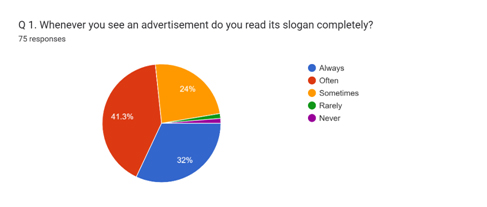
The above chart shows that while watching or reading an advertisement 41.3% of respondents often read its slogan and 32% always read the slogan. 24% of respondents answered that they sometimes only read advertisement slogan and only 1.3% says that they rarely or never read an advertisement slogan. The data analysis suggests that majority of respondents often read an advertisement slogan.
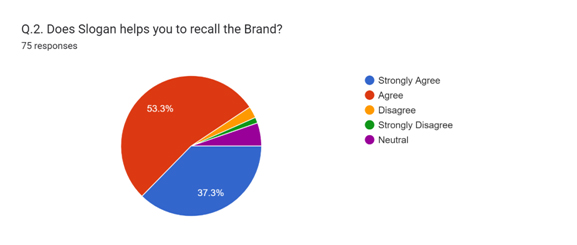
Researcher has tried to analyze weather an advertisement slogan adds on to the recall value of a brand or not. Above chart indicates that 37.3% of respondents strongly agrees to this point, 53.3% agrees that slogan helps to recall the brand. 5.3% of respondents can’t take any stand on this statement, while only 2.7% disagrees and 1.3% strongly disagrees from this statement. The data analysis shows that majority of respondents agrees that slogans are helpful in recalling a brand.
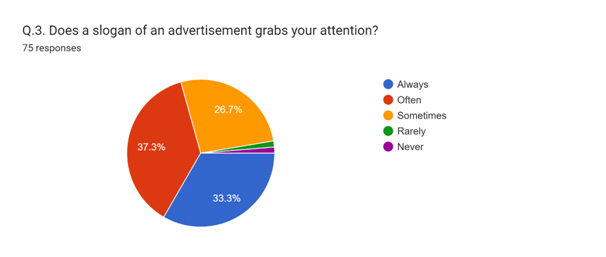
An advertisement comprises of various elements that grabs consumer’s attention. Above data shows that 37.3% of consumer admits that they are often attracted by the slogan of an advertisement and 33.3% are always attracted towards the slogan. 26.7% of respondents responded that a slogan grabs their attention sometimes and only 1.3% responded that it grabs their attention. The data clearly indicates that an advertisement slogan is a crucial element to grab consumer’s attention and influence their buying behavior.
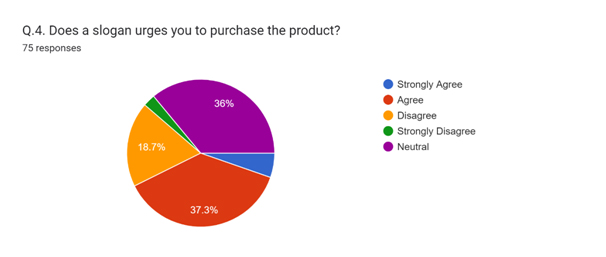
The above chart shows that how effective slogans are when a consumer takes buying decision. Out of 75 respondents, 37.3% agrees that a slogan urges them to purchase a product while 5.3% strongly agrees to this point. 36% of respondents were not able to take any stand on this statement. 18.7% of respondent disagreed and 1.3% strongly disagreed to this point.
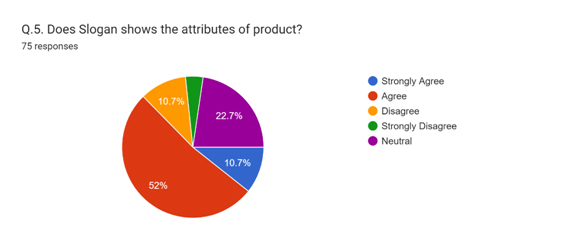
An advertisement often communicates about the attributes of a product through its graphics, images and text. Above chart identifies that weather a slogan shows attribute of product or not and how many respondents agrees to the same. The data analyzed shows that 52% of respondents agrees that a slogan shows attributes of product, 10.7% strongly agrees to this point. 22.7% of respondents can’t take any stand on this statement. 10.7% disagrees that slogan shows any attributes of product.
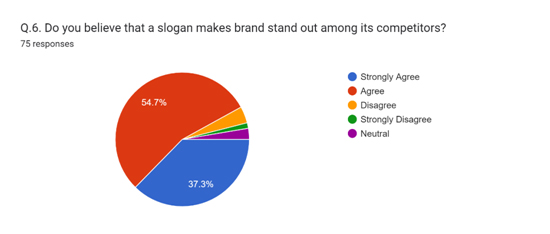
Advertisers and advertising agencies work day and night to make their product and brand stand unique in a crowd of its competitors. As slogan is an important element of advertisement it also helps them to stand out in crowd. Above chart shows that 54.7% of respondents agree that slogan makes brand stand out among its competitor and 37.3% strongly agree for the same. Only 3% disagree to the point and 2.7% can’t take a stand.
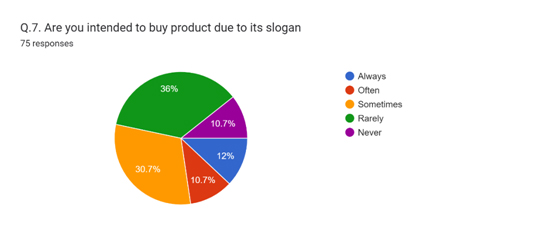
While there are many factors that affects buying decision of a consumer, here researcher tried to analyze weather slogan of an advertisement is also a factor that make consumer buy a product. Above chart indicates that 36% of respondents believe that a slogan rarely intends they to buy a product. 12% of respondents are always intended to buy a product due to its slogan, 30.7% are sometimes and 10.7% are often intended to buy a product to its slogan.
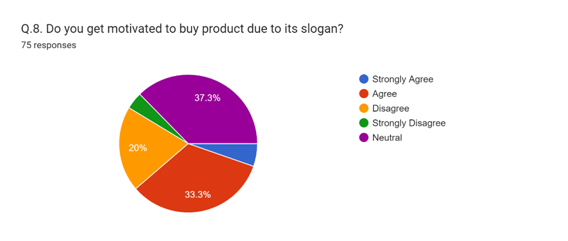
Motivation is first step that further leads consumer to take an action. Above chart indicates that weather slogan motivates consumers to buy product or not. The responses indicate that 33.3% of respondents agrees that they get motivated to buy a product due to its slogan, and 5.3% of respondents strongly agrees on same. 37.3% of respondents can’t take any stand and responded neutral on this question. 20% of respondents disagreed of getting motivated to buy a product due to its slogan and 4% of respondents strongly disagreed on same.
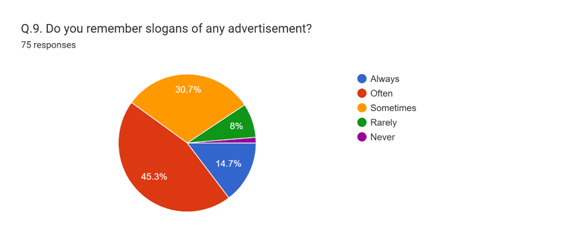
It is always said in advertising that a slogan should be simple, understandable and memorable. Researcher has tried to identify that weather consumers remember any advertisement slogans. Above chart shows that 14.7% of respondents always and 45.3% often remember the slogan of an advertisement. 30.7% of respondents responded that they sometimes remember the slogan and 8% of respondents rarely remember any slogan.
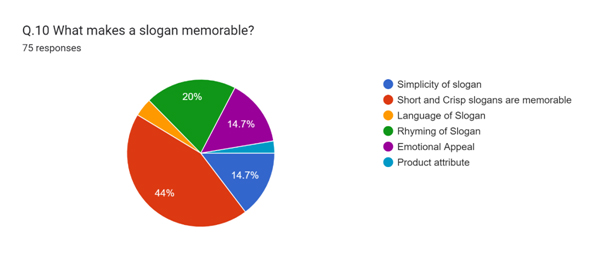
Researcher has tried to analyze the most important factor that makes a slogan memorable. Above chart indicates that 44% of respondents believes that short and crisp slogans are always memorable, 14.7% believe that it could be emotional appeal or simplicity of slogan that makes it memorable. 20% of respondents believe that it is the rhyming that makes it memorable and only 2.7% believe that it’s the product attributes in slogan which makes them memorable.
Findings and Discussion
Findings as per Objectives of the Study;
Importance of slogan in advertisements–There is no doubt slogan is a crucial element of any advertisement. The data shown above and analysis proves this as well. As 41.3% and 32% of respondents agrees that they always and often read slogan of an advertisement. Approx. 91% of respondents agrees that slogan helps them to recall brand name. approx. 63% believes that slogan shows attributes of a product. And, 54.7% of respondents agrees that slogan makes a brand stand out of its competitors. Analysis of this data clearly authenticates that slogans are very important for the success of any advertisement. they have enough potential to influence and persuade consumer.
Effect of advertising slogan on buying behavior of young consumers–The data analysis of this study clearly indicates that slogans have a positive effect on young consumer’s buying behavior. 33.3% and 5.3% agrees and strongly agrees that slogan motivates them to buy a product. Approx. 53% of respondents are sometimes or often intended to buy a product due to its slogan. And, approx. 43% of respondents agrees that slogan urges them to buy a product. Approx. 71% of respondents agrees that slogan of an advertisement often grabs their attention. Slogan makes the brand distinct, they persuade young consumer to buy a product.
The opinion of young consumers for improving effectiveness of advertising slogans–To adapt according to the ongoing changes in nature is the key to survival. And, to modify, innovate and create something unique is the key to survive in advertising world. To improvise effectiveness of slogans, it should be creative, simple, short and crisp. The data analysis also proves this as 44% of respondents believes that short and crisp slogans are more memorable. And, 20% believes that rhyming of slogan makes it more memorable, this is created by non-other than the creativity of writer.
Conclusion and Recommendation
The importance of a catchy, easily memorable slogan cannot be underestimated. First impressions count and in a highly competitive and crowded marketplace if you don’t immediately capture the consumer’s attention, the opportunity will likely be lost. Slogans can be a powerful way of extolling a product, and persuading people that they just ‘have to’ buy it. This study identifies and concludes that consumer’s buying behavior is strongly affected by the ad slogan an it helps the brand to stand out in a crowd of its competitors. With the attributes of product embedded in slogans it makes consumer recall the brand by creating an image in consumer mind. Both descriptive and inferential result depicts the significance of ad slogan in young consumer buying behavior. The study shows that 53% change in consumer purchase intention is due to advertising slogan.
Limitations: The study is conducted in small area of Bhopal city of Madhya Pradesh. It should be conducted in vast area of Madhya Pradesh.
Recommendation: The further study can be conducted with a larger sample size by incorporating other variables into study and moreover factor analysis can also be conducted to determine the factors that make the ad slogan effective. The study can be done in a specific sector.
References:
- Adhikari, Prahlad, 2018, Effect of Corporate Slogan on decision making of Consumer, SOJ Psychology.
- Alamgir et al. 2010. Influence of brand name on consumer decision making process – An empirical study on car buyers. Vol (10).
- David &Roswinanto.2014.Can vague brand slogans promote desirable consumer responses. Journal of Product & Brand Management, Vol. 23 Iss: 4/5, pp.282 – 294.
- Demirel, Cagatay and Aslan, Emre S., The Slogan Effect; The power of Brand Discourse in liking and purchasing Behavior.
- Juliano et al. 2011. The Curious Case of Behavioral Backlash: Why Brands Produce Priming Effects and Slogans Produce Reverse Priming Effects. The Journal of Consumer Research, Vol. 37, pp. 999-1014
- Kare Bjorkstrand. 2012. Does brand strength effect consumer attitude towards slogan.
- Khalid, Rizwan and Yasmeen, Tehreem. 2017. Effect of Advertising Slogans on consumer purchase intention in Pakistan.Journal of Basic and Applied Scientific Research. Vol.9.
- Kristy and Sandra. 2011. Running Head: Hemispheric Processing of Slogans Brand Familiarity in Advertisement Slogans: The Role of the Left and Right Cerebral Hemispheres. International journal of Marketing studies, Vol.3.
- Sharma Mohit, and SethiAmit. 2021.Impact of Advertising Slogan on customer buying intention with reference to soft drinks in Ludhiana. International Journal of Research Publication and Reviews.
- Supphellen and Nygaardsvik. 2002. Impact of Advertising Slogans on consumers. https://www.ukessays.com/essays/marketing/impact-of-advertising-slogans-on-consumers-marketingessay.php.
- Slogans that encourage thrift have opposite effectshttp://www.digitalsignage.net/2011/05/09/slogans_and_spending.
- Somayeh and Abdollah. 2013. The importance of advertising slogans and their proper designing in brand equity. International journal of organizational leadership. Vol-2.
[1]Faculty member, Makhanlal Chaturvedi National University of Journalism and communication, Bhopal

